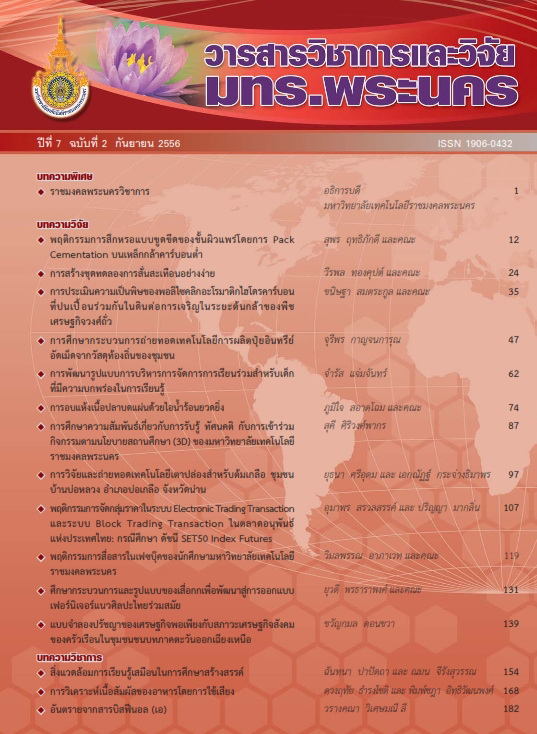การศึกษากระบวนการถ่ายทอดเทคโนโลยีการผลิตปุ๋ยอินทรีย์อัดเม็ดจากวัสดุท้องถิ่นของชุมชน
Main Article Content
Abstract
บทคัดย่อ
การวิจัยแบบมีส่วนร่วมนี้มีเป้าหมายหลัก คือ ศึกษากระบวนการถ่ายทอดเทคโนโลยีการผลิตปุ๋ยอินทรีย์อัดเม็ดของชุมชนหนองกระทุ่ม ด้วยวิธีวิจัยเชิงคุณภาพ วิจัยกึ่งเชิงทดลอง เครื่องมือสำคัญในการวิจัย คือ การสัมภาษณ์ แบบสอบถาม และโครงการอบรมถ่ายทอดเทคโนโลยี กลุ่มตัวอย่างและผู้ให้ข้อมูลสำคัญคือ ตัวแทนเกษตรกรที่เข้าร่วมในโครงการ และผู้ถ่ายทอดเทคโนโลยี วิเคราะห์สังเคราะห์ข้อมูลโดยการวิเคราะห์เนื้อหา วิเคราะห์เชิงสรุปแบบอุปนัย สถิติพื้นฐาน Wilcoxon Sign-Rank test ผลการวิจัยพบว่ากระบวนถ่ายทอดเทคโนโลยีแบ่ง3ขั้นคือ 1) ขั้นความรู้การจูงใจ 2)ขั้นไตร่ตรองตัดสินใจ 3) ขั้นทดลองปฏิบัติ คือ อบรมครั้งที่1 ครั้งที่2 มีตัวแทนเกษตรกรสามารถเข้าร่วมครบสองครั้ง 8 คน ซึ่งมีค่าคะแนนเฉลี่ยรวมความพึงพอใจเทคโนโลยีก่อนและหลังอบรมระดับปานกลาง(=3.28)และสูงมาก(=4.25)ตามลำดับ โดยส่วนใหญ่มีความคาดหวังสูงและสูงมากในการนำไปใช้ประโยชน์ ก่อนและหลังการอบรมร้อยละ62.5และ87.5ตามลำดับ เมื่อเปรียบเทียบคะแนนอันดับความคาดหวังโดยใช้ Wilcoxon Sign-Rank test พบว่ามีความแตกต่างอย่างมีนัยสำคัญสถิติที่ระดับ.05
Abstract
The main objective of this participatory research was to study technology transfer process for producing granule organic fertilizer in Nongkrathum community using qualitative and semi-experimental methodology. The main instruments consisted of interview, questionnaire, and training. The samples and key informants were farmers and technology instructors. Data analysis and synthesis involved content and inductive analysis, fundamental statistical analysis, and Wilcoxon Sign-Rank test. Results showed that the technology transfer process was divided into three stages: 1) Knowledge and persuasion stage, 2) Decision stage, and 3) Implementation stage which included 2 training sessions. Only eight of farmers could participate in both training sessions. The total mean scores of satisfaction in technology were at moderate level (=3.28) before training and very high level (=4.25) after training. Regarding expectation of utilizing the technology before training, 62.5% of farmers had high expectation. However, 87.5% of the farmers had a very high expectation after training. Comparison of expectations before and after training showed significant differences at the level of .05.

